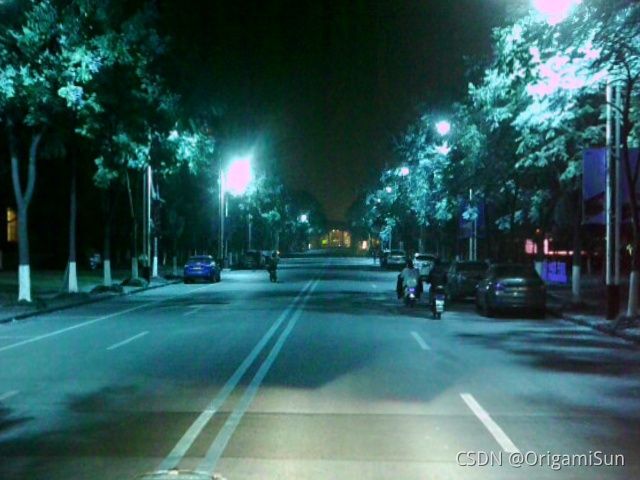可见光相机与红外相机标定
目录
1.打开相机
2.可见光相机畸变矫正
安装相关库
查看相机参数
修改launch文件
启动标定程序
启动矫正图像节点
3.查看相机图像
4.计算H举矩阵
手动标注获取每一组的H矩阵(h.py)
计算出平均H矩阵并查看标定效果(MeanH_Test.py)
5.接受、处理、发送图像(biaoding.py)
6.标定效果
1.打开相机
cd camera_ws
source devel/setup.bash
roslaunch usb_cam usb_cam-dual_model_rectified.launch2.可见光相机畸变矫正
安装相关库
catkin_make -DCATKIN_WHITELIST_PACKAGES="aruco;aruco_ros;aruco_msgs"
catkin_make -DCATKIN_WHITELIST_PACKAGES="aruco_mapping;lidar_camera_calibration"
catkin_make -DCATKIN_WHITELIST_PACKAGES=""
查看相机参数
ls /dev/video* #查看video个数和名称
v4l2-ctl -d 0 --all #查看video0的参数修改launch文件
启动标定程序
rosrun camera_calibration cameracalibrator.py --size 8x6 --square 0.06 image:=/usb_cam/image_raw camera:=/usb_cam
- 移动标定板时,标定窗口中的各指标增加。
- 当CALIBRATE按钮亮起时,单击计算相机内参矩阵及矫正参数,并输出至终端,此过程可能需要1-2分钟。
- 当SAVE按钮亮起时,单击将采集的样本图片和计算结果保存
- 当COMMIT按钮亮起时,单击将标定结果写入
~/.ros/camera_info/head_camera.yaml。注:此标定文件将被原始图像节点usb_cam读取,标定参数会被发布至话题/usb_cam/camera_info以供矫正图像节点image_proc使用。
启动矫正图像节点
ROS_NAMESPACE=/cam_rgb/usb_cam rosrun image_proc image_proc3.查看相机图像
rqt_image_view4.计算H举矩阵
手动标注获取每一组的H矩阵(h.py)
#!/usr/bin/python
# -*- coding: UTF-8 -*-
from PIL import Image
import cv2
import numpy as np
import pylab as pl
import matplotlib.pyplot as plt
import scipy.io as sio
from PIL import Image
def re_img(path):
img = cv2.imread(path)
a=int(20) #x start
b=int(700) #x end
c=int(0) #y start
d=int(510) #y end
cropimg=img[c:d,a:b]
imgresize=cv2.resize(cropimg,(640,480))
return imgresize
if __name__ == '__main__' :
num = 9
h=np.zeros((3,3))
# 读取红外图.
inf_Fig = "./rgb1/" + str(num) +"_dual.png"
img_dst = re_img(inf_Fig)
pl.figure(), pl.imshow(img_dst[:, :, ::-1]), pl.title('dual')
# 红外图中的4个点
dst_point = plt.ginput(4)
dst_point = np.float32(dst_point)
# 读取RGB图像.
RGB_Fig_1 = "./rgb1/"+ str(num) +".png"
im_src_1 = cv2.imread(RGB_Fig_1)
pl.figure(), pl.imshow(im_src_1[:, :, ::-1]), pl.title('rgb1')
# RGB图中的4个点
src_point_1 = plt.ginput(4)
src_point_1 = np.float32(src_point_1)
# Calculate Homography
h, status = cv2.findHomography(src_point_1, dst_point)
# Warp source image to destination based on homography
im_out_1 = cv2.warpPerspective(im_src_1,h,(640,480),borderValue=(255,255,255))
pl.imshow(im_out_1[:, :, ::-1]), pl.title('out')
pl.show() #show dst
#保存H矩阵
H1_name = 'h'+str(num)+'.mat'
print('H1:',h)
sio.savemat(H1_name, {'Homography_Mat_1':h})计算出平均H矩阵并查看标定效果(MeanH_Test.py)
#!/usr/bin/python
# -*- coding: UTF-8 -*-
from PIL import Image
import cv2
import numpy as np
#import pylab as pl
#import matplotlib.pyplot as plt
import scipy.io as sio
import time
class bd():
def get_time_stamp(self):
ct = time.time()
local_time = time.localtime(ct)
data_head = time.strftime("%Y-%m-%d %H:%M:%S", local_time)
data_secs = (ct - int(ct)) * 1000
time_stamp = "%s.%03d" % (data_head, data_secs)
#print(time_stamp)
stamp = ("".join(time_stamp.split()[0].split("-"))+"".join(time_stamp.split()[1].split(":"))).replace('.', '')
#print(stamp)
return stamp
def re_img(self,img):
#img = cv2.imread(path)
a=int(20) #x start
b=int(700) #x end
c=int(0) #y start
d=int(510) #y end
cropimg=img[c:d,a:b]
imgresize=cv2.resize(cropimg,(640,480))
return imgresize
def H_use(self,fig1):
name_1 = 'H11.mat'
data = sio.loadmat(name_1)
h1 = data['Homography_Mat_1']
h1[0][2]=h1[0][2]+30 #根据实际效果的修正
h1[1][2]=h1[1][2]+10
#print(h1[0][2])
#print(h1)
im_out_1 = cv2.warpPerspective(fig1,h1,(640,480))
return im_out_1
def Htest(self,path1,path2):
im_src_1 = cv2.imread(path1)
img_dst = self.re_img(path2)
im_out_1= self.H_use(im_src_1)
#pl.figure(),pl.imshow(img_dst[:, :, ::-1]), pl.title('dst'),
#pl.figure(),pl.imshow(im_out_1[:, :, ::-1]), pl.title('out1'),
#pl.show()
return im_out_1, img_dst
def Htest_t(self,img_t):
img_dst = self.re_img(img_t)
return img_dst
def Htest_rgb(self,img_rgb):
im_out_1= self.H_use(img_rgb)
return im_out_1
def cal_H(self):
num=0
H=np.zeros((3,3))
while int(num) < 10:
print(num)
name = 'h' + str(num) +'.mat'
data=sio.loadmat(name)
h = data['Homography_Mat_1']
print("h:",h)
num = num + 1
H=H+h
H=H/10
H1_name = 'H.mat'
print('H1:',H)
sio.savemat(H1_name, {'Homography_Mat_1':H})
if __name__ == '__main__' :
B=bd()
num=0
#B.cal_H()
while int(num)<10:
rgb_path="./rgb1/"+str(num)+".png"
t_path="./rgb1/"+str(num)+"_t.png"
img_rgb,img_t = B.Htest(rgb_path,t_path)
cv2.imwrite('./out/'+str(num)+'.png',img_rgb)
cv2.imwrite('./out/'+str(num)+'_t.png',img_t)
num=num+1
time=B.get_time_stamp()
print(time)5.接受、处理、发送图像(biaoding.py)
#! /usr/bin/env python2
from __future__ import print_function
#python2
import os
import roslib
import rospy
from std_msgs.msg import Header
from std_msgs.msg import String
from sensor_msgs.msg import Image
# from ros_numpy import msgify
from cv_bridge import CvBridge
import sys
sys.path.remove('/opt/ros/melodic/lib/python2.7/dist-packages')
import threading
import time
import numpy as np
import MeanH_Test as biao
import cv2
import threading
#python3
class SubscribeAndPublish:
def __init__(self):
self.all_obstacle_str=''
self.sub1_name="/cam_rgb/usb_cam/image_rect_color"
#self.sub1_name="/cam_rgb/usb_cam/image_raw"
self.sub1= rospy.Subscriber(self.sub1_name, Image,self.callback_rgb)
self.sub2_name="/cam_t/usb_cam/image_raw"
self.sub2= rospy.Subscriber(self.sub2_name, Image,self.callback_t)
self.rate = 10
self.timer = rospy.Timer(rospy.Duration(1.0 / self.rate), self.callback_timer)
self.lock_rgb = threading.Lock()
self.lock_t = threading.Lock()
self.img_rgb_global = []
self.img_t_global = []
self.pub1_name="pub_rgb"
self.pub1= rospy.Publisher(self.pub1_name, Image,queue_size=1)
self.pub2_name="pub_t"
self.pub2= rospy.Publisher(self.pub2_name, Image,queue_size=1)
self.mode=0
self.path_rgb='./img/img_rgb'
self.path_t='./img/img_t'
# self.bridge = CvBridge()
def callback_rgb(self,data):
print('callback1')
self.lock_rgb.acquire()
img = np.frombuffer(data.data, dtype=np.uint8).reshape(data.height, data.width, -1)
if len(self.img_rgb_global) > 0:
self.img_rgb_global.pop(0)
self.img_rgb_global.append(img)
else:
self.img_rgb_global.append(img)
self.lock_rgb.release()
#print('rgb')
#img = CvBridge().imgmsg_to_cv2(data, "bgr8")
#img = np.frombuffer(data.data, dtype=np.uint8).reshape(data.height, data.width, -1)
#print(img.shape)
#B=biao.bd()
#time=B.get_time_stamp()
#name='rgb_'+str(time)+'.jpg'
#img_rgb=B.Htest_rgb(img)
#cv2.imwrite('./img/img_rgb/'+str(name),img_rgb)
#self.pub1.publish(CvBridge().cv2_to_imgmsg(img_rgb,"bgr8"))
def callback_t(self,data):
print('callback2')
self.lock_t.acquire()
img = np.frombuffer(data.data, dtype=np.uint8).reshape(data.height, data.width, -1)
if len(self.img_t_global) > 0:
self.img_t_global.pop(0)
self.img_t_global.append(img)
else:
self.img_t_global.append(img)
self.lock_t.release()
#print('t')
#img = CvBridge().imgmsg_to_cv2(data, "bgr8")
#img = np.frombuffer(data.data, dtype=np.uint8).reshape(data.height, data.width, -1)
#print(img.shape)
#B=biao.bd()
#time=B.get_time_stamp()
#name='t_'+str(time)+'.jpg'
#img_t=B.Htest_t(img)
#cv2.imwrite('./img/img_t/'+str(name),img_t)
# self.pub2.publish(CvBridge().cv2_to_imgmsg(img_t,"bgr8"))
def callback_timer(self, event):
print('callback')
self.lock_rgb.acquire()
if len(self.img_rgb_global) > 0:
img_rgb = self.img_rgb_global[0].copy()
else:
return
self.lock_rgb.release()
self.lock_t.acquire()
if len(self.img_t_global) > 0:
img_t = self.img_t_global[0].copy()
else:
return
self.lock_t.release()
B=biao.bd()
time=B.get_time_stamp()
img_rgb=B.Htest_rgb(img_rgb)
img_t=B.Htest_t(img_t)
img_rgb=img_rgb[:,:,::-1]
img_t=img_t[:,:,::-1]
self.mode=mode
if self.mode==0:
self.path_rgb=path_rgb
self.path_t=path_t
cv2.imwrite(self.path_rgb+'/rgb_'+str(time)+'.jpg',img_rgb)
cv2.imwrite(self.path_t+'/t_'+str(time)+'.jpg',img_t)
print('save image successful!')
self.pub1.publish(CvBridge().cv2_to_imgmsg(img_rgb,"rgb8"))
self.pub2.publish(CvBridge().cv2_to_imgmsg(img_t,"rgb8"))
def main(mode,path_rgb,path_t):
rospy.init_node('biaoding_ws', anonymous=True)
#####################
t=SubscribeAndPublish()
#####################
rospy.spin()
if __name__ == "__main__":
mode=0
if len(sys.argv)>1:
mode=int(sys.argv[1])
if mode>1:
mode=1
else:
mode=0
print(mode)
if mode==0:
print("save image")
else:
print("no save image")
#create dirs
b=biao.bd()
ti=b.get_time_stamp()
path='./img'+str(ti)
folder=os.path.exists(path)
if not folder:
os.makedirs(path)
path_rgb=path+'/img_rgb'
os.makedirs(path_rgb)
path_t=path+'/img_t'
os.makedirs(path_t)
main(mode,path_rgb,path_t)

